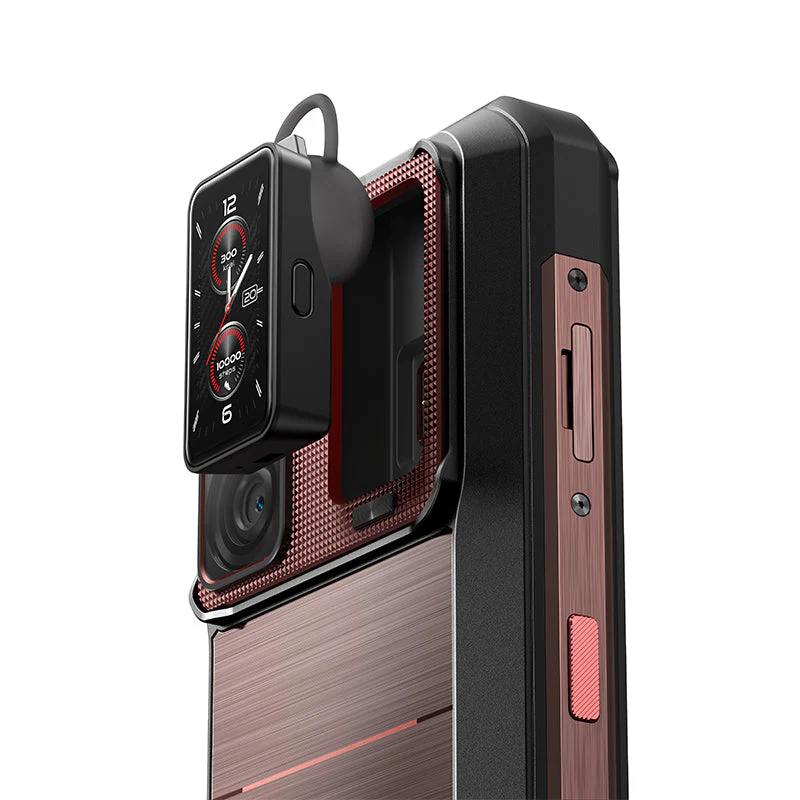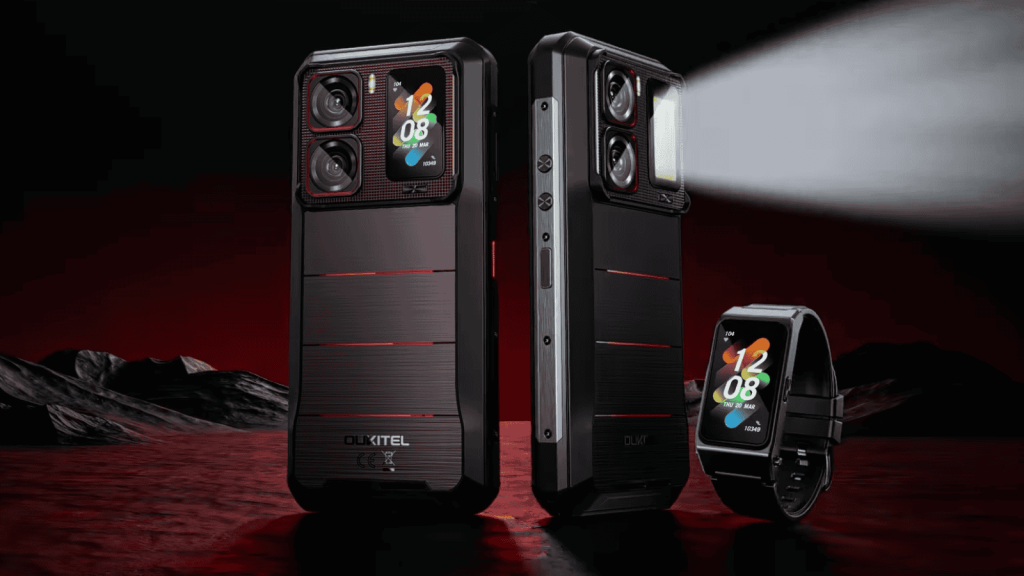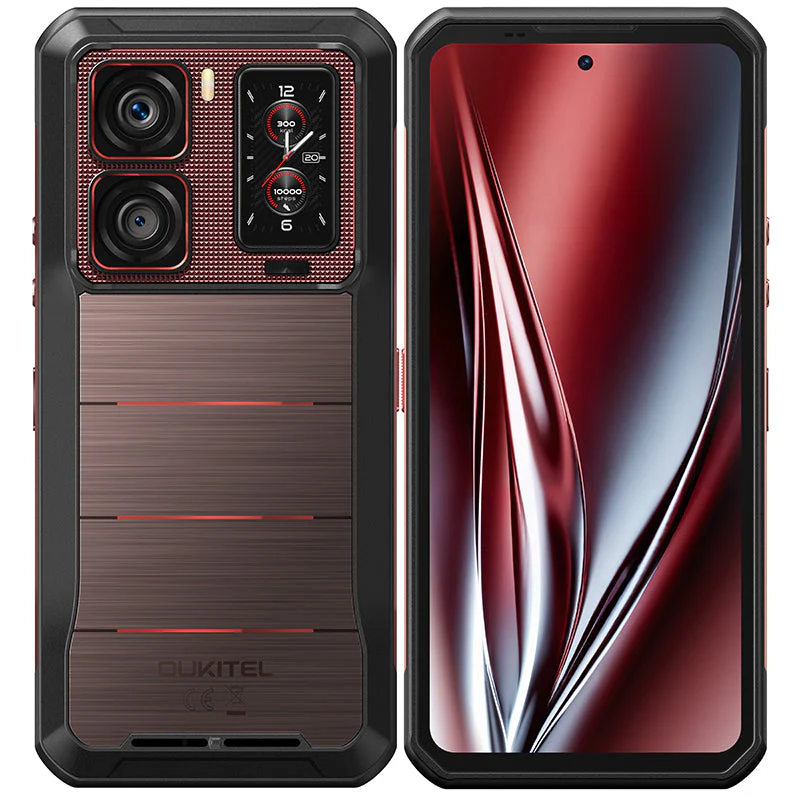The Oukitel WP300 is designed for those seeking a device with excellent battery life, durability, and additional tools that make it more versatile. We used it for a week with 5G connectivity, navigation, videos, music, and other daily tasks to understand its performance under real-world conditions. Discover our conclusions from the experience.
Design and Build — Rugged, Large, and Functional
The WP300 is built with a combination of metal and rubber that conveys a strong sense of durability. During our outdoor testing, we noticed the device is clearly designed to withstand demanding conditions.

The back includes the NFC reader, while the sides feature comfortable physical buttons and a configurable multifunction key. The SIM tray can be opened without tools, something we especially valued during travel. The USB-C port is protected by a somewhat difficult-to-open cover, but necessary to ensure protection against water and dust.
Pros
Durable metal and rubber body
Accessible buttons and configurable multifunction key
Tool-free SIM tray
Cons
No headphone jack
Impractical USB-C cover
Performance and Features — Sufficient for Daily Use
The WP300 includes the MediaTek Dimensity 7050 processor. While not high-end, we felt its moderate frequency helped extend battery life without affecting overall smoothness.
The experience was positive during navigation, multimedia content playback, and app usage. The Android 15 operating system comes in a clean version, without bloatware or interference, which we greatly appreciated.
We were able to run artificial intelligence applications like Gemini thanks to the 12GB of real RAM and additional virtual RAM. We configured the side key to activate useful functions like the flashlight or camera, which proved very practical.
Pros
Clean Android without unnecessary pre-installed apps
Compatible with AI apps and banking services
Easy customization of side button
Cons
Limited performance compared to more powerful processors
Battery and Autonomy — Built to Last Without Interruption
The battery is undoubtedly the WP300’s biggest attraction. With intensive use over several days, including 5G and many hours of active screen time, we achieved a full week of autonomy without needing to recharge.
During bike trips and camping, this was crucial. We also took advantage of its reverse charging function to power other devices. The fast charging is effective, but given the battery’s size, the complete charging process takes several hours.
Pros
Real autonomy of up to a week with intensive use
Useful and reliable reverse charging
Cons
Relatively long full charging time
User Experience — Useful Modules for Real Scenarios

The detachable modular watch was one of the accessories we used most. We connected it to the back of the phone and also used it with the included strap, both as a Bluetooth earpiece and to record data like steps, sleep, heart rate, and calories. Navigating its interface was simple, with intuitive gestures.
The camping light attached seamlessly and proved especially useful at nightfall. Its adjustable brightness and SOS mode were functional, and we could control it from the phone’s app. We appreciated that both accessories integrate into the system without complications.
The display proved to be smooth and readable even under direct sunlight. Unlike other rugged phones, we experienced no touch errors or ghost effects.
Pros
Functional modules that enhance outdoor experience
High refresh rate display with good visibility
Simple integration between phone, watch, and light
Cons
The watch has limited functions compared to dedicated smartwatches
Cameras — Good Under Adequate Conditions
The WP300 includes a 108MP main camera and a 2MP macro lens. In our tests, the main camera performed comparably to mid-range models like the iPhone 16e or Samsung Galaxy A54 5G, provided there was good lighting. We liked that the image processing doesn’t exaggerate colors, achieving more natural results.
We used portrait mode, beauty mode, and HDR, and also took advantage of the 108MP mode for better quality crops. The 32MP front camera was sufficient for group selfies.
For video, we reached 4K resolution. Digital stabilization worked well, considering that optical stabilization isn’t usually recommended for phones designed to withstand drops.
Pros
Natural colors and sharp results with good light
Useful 108MP mode for cropping and detail
4K video and wide selfies
Cons
Macro lens has little practical daily use
Absence of optical stabilization
Conclusion
The Oukitel WP300 is a good alternative for those who need a rugged phone with great autonomy and versatile modules for demanding activities. We consider it an excellent secondary or backup option for travel, outdoor work, or situations where a conventional device wouldn’t suffice.
What we valued most was its battery life and the real functionality of its modules. It’s not lightweight or ultra-powerful, but it delivers what it promises.
Technical Specifications
| Feature | Details |
| Dimensions | 177.3 x 82.4 x 23.2 mm |
| Weight | 510 g |
| Display | 6.8″ FHD+ (1080×2460), 120 Hz, Gorilla Glass 5, 650 nits, 396 ppi |
| Processor | MediaTek Dimensity 7050, Octa-core, 2x Cortex-A78 2.6 GHz + 6x A55 2.0 GHz |
| GPU | Mali-G68 MC4 |
| RAM/Storage | 12 GB LPDDR5x + 512 GB (up to 36 GB RAM and 2 TB expansion) |
| Operating System | Android 15 |
| Main Camera | 108 MP, f/1.88, S5KHM6SX03 sensor, PDAF, 4K video at 30 fps |
| Front Camera | 32 MP, f/2.2, Sony IMX616 sensor, FF, 1080p video at 30 fps |
| Macro Camera | 2 MP, f/2.2, GC02M1 sensor |
| Battery | 16,000 mAh, 45W fast charging, 18W reverse charging |
| Charging Times | 50% in 70 min, 80% in 120 min, 100% in 240 min |
| Connectivity | 5G, WiFi 6 (802.11 a/b/g/n/ac/ax), Bluetooth 5.2, NFC, USB-C, OTG |
| Networks | GSM, CDMA, WCDMA, TDD, FDD, 5G (full bands) |
| Navigation | GPS, GLONASS, Beidou, Galileo |
| Sensors | Side fingerprint, gyroscope, compass, proximity, ambient light, G-sensor |
| Durability | MIL-STD-810H, IP68/IP69K, -20°C to 55°C |
| In the Box | Phone, adapter, USB cable, SIM tool, screen protector, manual, warranty, modular watch, camping light |
Alternatives
Doogee V30T: Rugged phone with 120Hz display, 108MP main camera, and stereo sound. Good battery life, though it lacks detachable modules.
Ulefone Power Armor 18T: Features infrared temperature sensor, 9600 mAh battery, and smooth display. It’s lighter, though with less battery duration.
Blackview BL9000 Pro: Rugged device with integrated thermal camera, ultra-fast 120W charging, and focus on industrial environments. Doesn’t include modular accessories.
